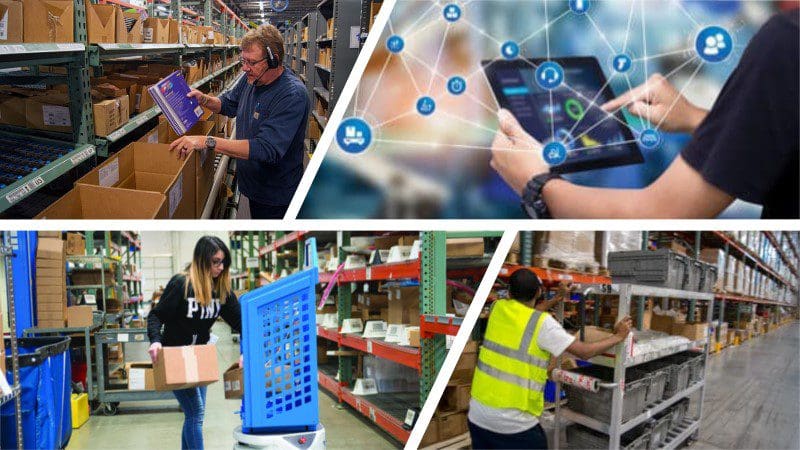[ad_1]
References to the new gig economy are ubiquitous nowadays and many say it has revolutionized the way businesses operate in today’s world. But what exactly is it? As defined by Oxford Languages, it is “a labor market characterized by the prevalence of short-term contracts or freelance work as opposed to permanent jobs.”
The warehouse and DC industry has always had somewhat of a gig culture, owing to seasonal and temporary labor needs. Some might say, what’s really the difference between the usual temporary or agency staffing models that the industry has used for years, and the gig economy? Much of it is indeed the same. But there are several differences:
- Job opportunities – Seasonal workers are typically hired through staffing agencies or directly by the company for specific time-limited roles, such as during peak seasons or to cover temporary staffing gaps. Gig workers access job opportunities through online platforms or mobile apps that connect them with employers or clients seeking short-term labor. They can choose from a variety of gigs or tasks available on these platforms and apply for the ones that match their skills and preferences.
- Length and type of engagement – Traditional temps are usually employed for a fixed duration, which could be a few weeks to a few months, depending on the company’s needs. Their engagement ends once the temporary period is over, and they may or may not be rehired for future seasons or projects. Gig workers engage in short-term, on-demand projects or tasks, which can range from a few hours to a few days or weeks. Their engagement is often project-based, and they have the flexibility to decide when and how much they want to work.
- Pay or benefits structure – Seasonal workers may receive hourly wages or a fixed salary, which is often governed by local labor laws and regulations. They may also be eligible for certain benefits such as overtime pay, workers’ compensation, and, in some cases, limited access to company benefits. Gig workers might more typically be paid for each completed gig or task rather than receiving a regular salary. They typically do not receive traditional benefits like health insurance, paid time off, or retirement plans.
3PL companies especially are partnering with the gig economy to take advantage of its flexibility. Let’s explore some of the impacts, good and bad, this new way of doing business has had and some specific considerations if you are looking at implementing a more specific strategy around it in your plans.
What’s driving the move to gig work?
First, technology has made it easier for individuals to connect with potential customers or employers and find work on a flexible basis. Platforms like Uber, Airbnb, and TaskRabbit have revolutionized the way that people can earn money and work on their own terms. In the warehousing space, popular platforms include Talroo, warehousegig.com or gigsmart.com.
Technology and its availability are also at the core of what makes certain work more attractive in the warehouse. In the recent Lucas Systems Voice of the Warehouse Worker survey, nearly 3 in 4 (74%) warehouse workers were at least somewhat likely to take a pay cut to work at another company with more technology tools to help them do their job. This was driven by younger workers, with 81% of workers in the Gen Z group being at least somewhat likely to trade pay for tech.
Another factor driving the move to gig work is a changing attitude towards work. Many people are seeking greater flexibility and control over their work-life balance, and the gig economy provides a way for them to achieve this. Economic pressures, including rising living costs and a lack of stable employment opportunities, have also contributed to the growth of the gig economy as workers seek alternative sources of income.
Adjustable staffing levels and better wages
With the advent of the gig economy, companies can now have enhanced flexibility without having to commit to longer-term contracts or salaries. More flexibility in workforce management helps to bring down overall cost, which can be passed down to the customer as well, and allows a warehouse or DC to offer its gig workers more competitive hourly wages. In some cases, employers are able to increase wages while actually reducing total labor costs.
On the Wonolo platform, warehouse jobs were the most popular, possibly owing to the fact that warehouse workers using the platform appear to earn 7.2% more than other warehouse workers. For that reason, warehouse and fulfillment jobs are extremely popular gigs on most job-hunting platforms.
Better access to specialized labor and better opportunities
As the DC becomes more automated and complicated, the need for specialized talent will continue to grow. For example, you’ll need more tech skills to manage the equipment (robots, hydrogen vehicles, ASRS). Some IT software skills may be necessary as more complex software is being installed. Mechanical skills for the MRO operation and engineering talent to do work like slotting and inventory optimization are possible. Many platforms like warehousegig.com or gigsmart.com offer access to pools of talent with varying skill sets and expertise, making it easier for employers to find specialized workers. This eliminates the need to invest time and resources into training new employees or conducting lengthy recruitment processes when there’s an urgent need for labor.
Additionally, workers can tailor their working hours according to their own needs and preferences. Workers have more options for finding flexible work arrangements that fit their schedules and lifestyles. Stressing the flexibility of gig work can also attract workers who may not have been able to commit to traditional schedules due to other obligations, such as childcare or education.
Aligning with the new culture and worker
While the gig structure has provided options for workers and operators as well, there are some fundamental adjustments that employers must understand and make to better attract both gig and permanent workers. While operations labor and benefit cost efficiencies might be realized through adoption of a gig strategy, investing in the training and tools to attract the best candidates and produce highly effective teams will still be a vital necessity. The average warehouse spends 6-8 weeks training and properly onboarding new employees, representing thousands of dollars in training costs per new hire.
The growing rise in tailored or intuitive training has also fed into the gig rise as people can get trained and be up and running in terms of productivity very quickly. Lucas Systems recent Competing for the warehouse workforce of the future insights found that workers valued the opportunity to work with technology that could help make their jobs easier and empower more efficiency. That meant things like voice systems, as well as scanners, conveyors and robots. One consistently cited factor in the survey, especially among younger workers, was the adaptability of training scenarios, and not a “one size fits all approach.” User-defined training is a wave of the future that workers are embracing. For example, the Lucas voice-directed system allows workers to control voice playback speeds to their own preference and comfort level, and interacts with new workers through different prompts and expected responses than with veteran users. Add to this mix that that both employers and employees can ‘rate’ the other on apps like VeryAble, similar to what Uber does, and it becomes even more important to make sure your culture, work flexibility and technology are aligned with the potential workforce.
Gig isn’t all good
While hiring gig workers can provide a flexible and cost-effective way to manage fluctuating demand for labor in the warehouse, it ultimately depends on the specific circumstances and goals of the company. In contrast to the benefits mentioned, relying too heavily on gig workers can create challenges in terms of job security and consistency of performance. Gig workers may not have the same level of commitment or investment in the company’s success as traditional employees. There may also be challenges in coordinating and communicating with a more diverse and dispersed workforce. There is just somewhat of an instability to the gig/seasonal aspect of work that some employers would rather avoid, opting for a more stable, reliable and familiar workforce, even though it may cost a little extra.
With its various advantages, the gig economy is sure to continue reshaping the way businesses operate in the future. You should be prepared with a strategy to ensure the continued growth and sustainability of your operation.
—
 Ron May is Founding Member and Senior Solution Consultant at Lucas Systems. A global expert on warehouse process optimization, voice-directed mobile applications, and user experience, he has nearly four decades of system design, development, and implementation experience. As its chief architect and software engineer, Ron developed Lucas software solutions, including its innovative voice-directed mobile applications.
Ron May is Founding Member and Senior Solution Consultant at Lucas Systems. A global expert on warehouse process optimization, voice-directed mobile applications, and user experience, he has nearly four decades of system design, development, and implementation experience. As its chief architect and software engineer, Ron developed Lucas software solutions, including its innovative voice-directed mobile applications.
He has collaborated on hundreds of distribution center projects, including the earliest implementations of speech recognition systems for non-picking processes, and groundbreaking multimodal systems combining voice, scanning, and other data entry techniques.
Prior to Lucas Systems, he helped commercialize industrial speech recognition technology at Westinghouse Electric. Ron has a B.S. from Case Western Reserve University in Electrical Engineering & Applied Physics and Applied Mathematics.
[ad_2]
Source link














